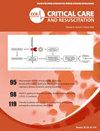应用蛛网膜下腔出血国际临床放射学预测模型评估重症监护病房收治的动脉瘤术后蛛网膜下腔出血患者的预后和死亡率
IF 1.7
4区 医学
Q3 CRITICAL CARE MEDICINE
引用次数: 0
摘要
本研究的目的是评估三级成人重症监护病房(ICU)队列中蛛网膜下腔出血国际试验(SAHIT)预测模型在评估患者预后与预测结果时的效果,首先评估该模型在亚历山德拉公主医院(PA)重症监护队列中的识别性和有效性,然后使用蒙特卡洛模拟将SAHIT模型的预测结果与实际队列结果进行比较。方法采用SAHIT协作组设计的6个logistic回归模型,考虑临床分级和治疗方式等早期预测因素,根据格拉斯哥预后评分(Glasgow outcome Score)预测6个月时的死亡风险和不良结局。将6个SAHIT logistic回归模型应用于回顾性收集的ICU收治的动脉瘤性蛛网膜下腔患者队列,生成死亡率和功能不良结局的个体风险评分。使用曲线下面积(AUC)、校准斜率/截距和Brier评分来评估模型在解释当前数据集方面的强度。使用蒙特卡罗分析比较实际死亡率结果与预测结果,以确定队列表现是否比死亡率模型预测的更好或更差。结果总体而言,PA队列的实际死亡率高于基于SAHIT模型风险评分的预测死亡率,使用SAHIT模型风险评分进行蒙特卡洛模拟。核心模型、神经影像学模型和功能预后的完整模型的auc分别为0.719(95%可信区间[CI]: 0.55-0.84)、0.709 (95% CI: 0.55-0.83)和0.738 (95% CI: 0.58-0.85)。关于死亡率,auc分别为0.684 (95% CI: 0.57-0.78)、0.678 (95% CI: 0.56-0.77)和0.749 (95% CI: 0.64-0.84)。关于校准,一般来说有适度的校准,在功能齐全的结果模型中有更高的校准程度。结论:队列结果的死亡率高于使用sahit创建的逻辑回归所提示的风险预测。应用外部训练的模型提供了充分的辨别和适度的校准,但在应用于重症监护队列时低估了风险,这反映在概率密度函数分析中。在该队列中使用SAHIT模型可能会导致对单个患者死亡率的低估,并且该模型的准确性不足以用于单个患者的预测。这些结果挑战了在动态ICU人群中使用基于入院的模型的适宜性,并强调了对重症护理特异性预后工具的迫切需要。本文章由计算机程序翻译,如有差异,请以英文原文为准。
Assessment of outcomes in postaneurysmal subarachnoid bleed patients admitted to the intensive care unit utilizing the subarachnoid haemorrhage international trialist clinicoradiological prediction model for dichotomised functional outcome and mortality
Objective
The objective of this study was to assess the Subarachnoid Haemorrhage International Trialist (SAHIT) prediction model in a tertiary adult intensive care unit (ICU) cohort when assessing patient outcomes against predicted outcomes, firstly by assessing the discrimination and validation of the model in the Princess Alexandra Hospital (PA) intensive care cohort and secondly comparing the predicted outcomes using the SAHIT model to the actual cohort outcomes using a Monte Carlo simulation.
Methods
Six logistic regression models designed by the SAHIT Collaboration Group were applied to the PA cohort considering early predictive factors such as clinical grade and treatment modality to predict the risk of both mortality and unfavourable outcome at 6 months according to the Glasgow Outcome Score. The six SAHIT logistic regression models were applied to a retrospectively collected cohort of aneurysmal subarachnoid patients who were admitted to the ICU, generating individual risk scores for mortality and poor functional outcome. Area under the curve (AUC) and calibration slope/intercept and Brier score were used to assess the strength of the model in interpreting the current data set. A Monte Carlo analysis was used to compare the actual mortality outcomes to the predicted outcomes to determine if the cohort performance was better or worse than predicted by the mortality model.
Results
Overall, the PA cohort actual mortality was higher than the predicted mortality rate based on the risk scores generated by the SAHIT models, demonstrated by Monte Carlo simulation using the SAHIT model risk scores. The core, neuroimaging, and full models for functional outcome produced AUCs of 0.719 (95% confidence interval [CI]: 0.55–0.84), 0.709 (95% CI: 0.55–0.83), and 0.738 (95% CI: 0.58–0.85). Regarding mortality, the respective AUCs were 0.684 (95% CI: 0.57–0.78), 0.678 (95% CI: 0.56–0.77), and 0.749 (95% CI: 0.64–0.84). Regarding calibration, there was modest calibration in general, with higher degrees of calibration in the fully functional outcome model.
Conclusion
The cohort outcomes for mortality occurred at a rate higher than the risk predictions suggested using the logistic regression created by the SAHITs. Applying the externally trained model provided adequate discrimination and modest calibration, yet underestimated risk when applied to the intensive care cohort, reflected in the probability density function analysis. Using the SAHIT models in this cohort may result in underestimation of mortality for the individual patient, and the accuracy of the model is not sufficient for individual patient prediction. These results challenge the appropriateness of using admission-based models for dynamic ICU populations and highlight the urgent need for critical care–specific prognostic tools.
求助全文
通过发布文献求助,成功后即可免费获取论文全文。
去求助
来源期刊

Critical Care and Resuscitation
CRITICAL CARE MEDICINE-
CiteScore
7.70
自引率
3.40%
发文量
44
审稿时长
>12 weeks
期刊介绍:
ritical Care and Resuscitation (CC&R) is the official scientific journal of the College of Intensive Care Medicine (CICM). The Journal is a quarterly publication (ISSN 1441-2772) with original articles of scientific and clinical interest in the specialities of Critical Care, Intensive Care, Anaesthesia, Emergency Medicine and related disciplines.
The Journal is received by all Fellows and trainees, along with an increasing number of subscribers from around the world.
The CC&R Journal currently has an impact factor of 3.3, placing it in 8th position in world critical care journals and in first position in the world outside the USA and Europe.
 求助内容:
求助内容: 应助结果提醒方式:
应助结果提醒方式:


